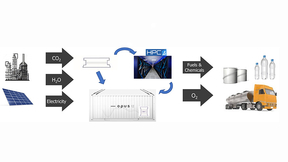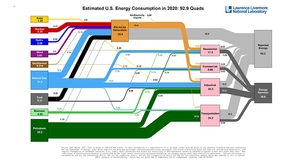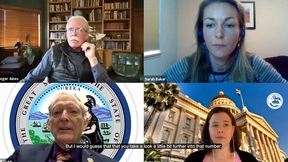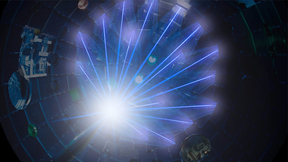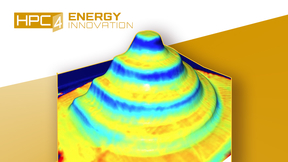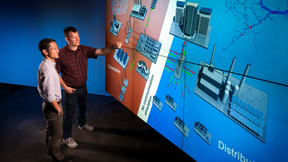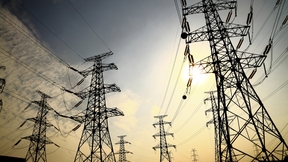Back
Several Lawrence Livermore National Laboratory (LLNL) scientists played key roles in the 25th annual meeting of the Nuclear Forensics International Technical Working Group (ITWG), which met last month. The event, which was conducted in a virtual setting for the first time, was attended by more than 100 experts from 30 countries and highlighted the group’s notable…
U.S. Secretary of Energy Jennifer M. Granholm virtually visited Lawrence Livermore National Laboratory (LLNL) Friday, June 25, where she met with leading scientists and engineers, toured lab facilities and learned about key research efforts. Granholm, the nation’s 16th Secretary of Energy and only the second woman to lead the Department of Energy (DOE), is conducting…
The Department of Energy (DOE) today announced awards of $3.7 million for 13 new High Performance Computing for Energy Innovation (HPC4EI) projects, including a collaboration involving Lawrence Livermore National Laboratory (LLNL) targeted at improving CO2 conversion. DOE’s Advanced Manufacturing Office (AMO) – an office within DOE’s Office of Energy Efficiency and…
A team of Lawrence Livermore National Laboratory (LLNL) researchers, in partnership with two other national laboratories, has launched a project studying the viability of large-scale hydrogen storage in geologic formations. Researchers from LLNL, Pacific Northwest Laboratory (PNNL) and the National Energy Technology Laboratory (NETL) will receive up to $6.75 million over…
Lawrence Livermore National Laboratory (LLNL) engineer Bill Pitz has earned a lifetime distinguished achievement award from the Department of Energy’s Vehicle Technologies Office (DOE VTO) for his significant contributions to the field of chemical kinetics. Pitz, along with retiree Charles Westbrook, produced a chemical kinetic study of fuel additives for engine knock in…
Americans used approximately 7 percent less energy in 2020, due in part to the COVID-19 pandemic, according to energy flow charts released by Lawrence Livermore National Laboratory (LLNL). Each year, LLNL releases flow charts that illustrate the nation's consumption and use of energy. Americans used 92.9 quads (quadrillion BTU) of energy, which is 7.2 quads less or 7…
When it comes to California implementing a carbon capture and storage program to reach the state’s goal of carbon neutrality by 2045, nothing too newfangled needs to take place. During a forum titled “Carbon Capture and Sequestration in California: Regional Insights and Community Attitudes,” a group of scientists, California policymakers and industry leaders came together…
An influential Department of Energy (DOE) advisory committee has recommended that the nation move aggressively toward the deployment of fusion energy, including investments in technology and equipment to support one of the core missions of LLNL’s National Ignition Facility (NIF) — laying the groundwork for the development of inertial fusion energy (IFE). The report,…
Kim Budil has been named director of Lawrence Livermore National Laboratory (LLNL). Charlene Zettel, chair of Lawrence Livermore National Security, LLC (LLNS), which manages the Laboratory for the Department of Energy's (DOE) National Nuclear Security Administration (NNSA), made the announcement to Laboratory employees Jan. 28. Budil will begin her new role on March 2…
Lawrence Livermore National Laboratory (LLNL) employees, participating in 10 project teams, recently earned Department of Energy (DOE) Secretary Achievement Awards. Representing some of the highest internal, non-monetary recognition that DOE employees and contractors can receive, these awards recognize DOE employees and contractors for their service and contributions to…
Lawrence Livermore National Laboratory (LLNL) scientists and engineers have put together another first-rate year securing major grants through the Department of Energy’s (DOE) Technology Commercialization Fund (TCF). “We did quite well, although the diversity of the research projects funded wasn’t as broad as last year,” said Rich Rankin, the director of the Lab’s…
The High Performance Computing for Energy Innovation (HPC4EI) Program, managed by Lawrence Livermore National Laboratory (LLNL) for the U.S. Department of Energy (DOE), is seeking new industry proposals for short-term projects that could benefit from world-class DOE high performance computing (HPC) and expertise. Under the fall 2020 HPC4EI solicitation, DOE’s Office of…
The Department of Energy (DOE) today announced two rounds of awards for the High Performance Computing for Energy Innovation Program (HPC4EI), including five projects at Lawrence Livermore National Laboratory (LLNL). HPC4EI connects industry with the computational resources and expertise of the DOE national laboratories to solve challenges in manufacturing, accelerate…
Thermoelectric materials convert heat to electricity or vice versa. However, their application to harvest waste heat is limited by challenges in fabrication and materials. Finding cost-effective ways to cover large and potentially complex surfaces has remained an issue but is crucial to take advantage of waste heat sources. Lawrence Livermore National Laboratory (LLNL)…
The High Performance Computing for Energy Innovation (HPC4EI) Program, managed by Lawrence Livermore National Laboratory (LLNL), has issued a special solicitation seeking industry partners to collaborate with the Department of Energy’s (DOE’s) national laboratories on projects to improve manufacturing processes. This special solicitation invites members of Manufacturing…
Lawrence Livermore National Laboratory (LLNL) has opened a center that will develop new materials for energy applications from inception to technology demonstration. The Laboratory of Energy Applications for the Future (LEAF) was formed to coordinate research efforts for energy- and environment-related technologies and capabilities. “LEAF will address crucial science and…
Lawrence Livermore National Laboratory (LLNL) recently launched a new initiative focused on sharing solutions developed at the Lab with local communities to help them develop a sustainable, resilient and affordable energy infrastructure. Under the initiative, LLNL will share its expertise in advanced clean energy technologies — such as microgrids, energy-efficient "smart"…
A Lawrence Livermore National Laboratory (LLNL) team has successfully deployed a widely used power distribution grid simulation software on a high-performance computing (HPC) system, demonstrating substantial speedups and taking a key step toward creating a commercial tool that utilities could use to modernize the grid. Partnering with power management company Eaton to use…
The Department of Energy’s Building Technologies Office (BTO) within the Office of Energy Efficiency & Renewable Energy (EERE) recently awarded Lawrence Livermore National Laboratory (LLNL) researchers with $3 million for a three-year project aimed at using building energy more efficiently to shave peak electric energy usage. The project, led by LLNL power systems…
Renewable energy is on the rise, especially in California, where utility companies are mandated to get at least half of their power from renewable resources, such as solar and wind, by 2030. It may be a positive development for the environment, but questions linger about how electricity generated by residential solar panels and home battery storage can affect the stability…



